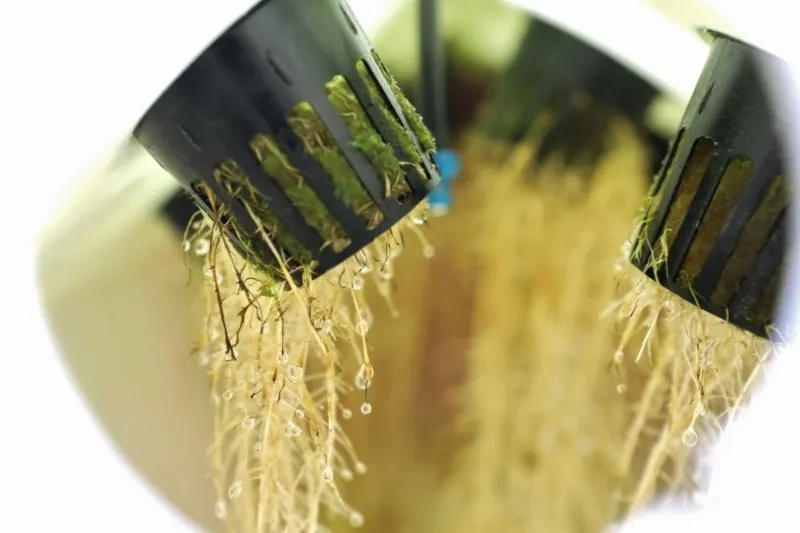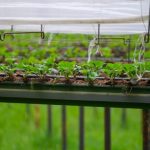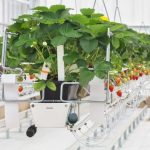Aeroponics takes plant cultivation to new heights, allowing you to grow your plants without the need for soil or a substrate culture. At the heart of this advanced technology is an essential process known as misting, which plays a vital role in delivering the necessary nutrients for your plants to thrive.
Misting in aeroponic systems involves the use of specially designed nozzles to produce a fine spray of nutrient-rich solution directly onto the roots of your plants. This ingenious approach enables an efficient and incredibly effective absorption of nutrients, as the mist provides increased surface area coverage for your plant roots to uptake every ounce of nourishment.

In an aeroponic setup, it’s crucial to understand the significance of aeroponics misting frequency to ensure the health of your plants through all their growth stages. Adjusting the timing and duration of mist cycles to strike the right balance promotes optimal growth while preventing the plant roots from drying out.
For encouraging the best root development in an aeroponic system, it’s important to lightly spray the roots every several minutes for just a few seconds. Ensure that the roots remain moist, but not overly soaked with excess nutrient solution dripping off them.
As you delve deeper into the world of aeroponics, you’ll discover that perfecting your misting technique can make all the difference in the success of your gardening endeavors.
Aeroponics Misting Frequency
Understanding Aeroponics Watering Schedule
Understanding the importance of an aeroponics watering schedule is crucial to the success of your aeroponic growing system. This watering schedule determines how often and for how long your plants receive nutrient solution mists, essential for their growth and development.
In an aeroponic system, plants’ roots are suspended in air and periodically misted with a nutrient-rich solution. Unlike traditional soil gardening or hydroponics where roots are constantly submerged in water or a nutrient solution, aeroponics presents a different challenge regarding water and nutrient delivery.
Having a well-structured aeroponics timer schedule ensures that your plants obtain all the necessary nutrients they need to thrive while also maintaining oxygenation, which is vital for root health. Too frequent watering can drown the roots, leading to oxygen deprivation; on the contrary, infrequent watering can lead to dehydration. Therefore, achieving a balance is integral.
Benefits of Proper Misting Frequency
The benefits of proper misting frequency are numerous. Adequate misting promotes healthier root systems by providing the right balance between water/nutrient intake and oxygenation. When roots receive appropriate amounts of both nutrients and oxygen, plant growth accelerates significantly.
Maintaining proper oxygen levels in your aeroponic system will significantly impact the overall growth and health of your plants. When roots are provided with an ample supply of oxygen, they can efficiently uptake water and nutrients, promoting faster growth and improved resilience against diseases. For an aeroponic system, the dissolved oxygen concentration in the nutrient solution plays a vital role in plant growth. A higher concentration of oxygen in the solution helps enhance root growth and nutrient uptake.
In an aeroponic system, there is rapid uptake and absorption of nutrients. This provides several benefits:
- Faster growth: Since nutrients are absorbed quickly, the plants grow at a faster rate.
- Precise control: You can easily adjust the nutrient concentration or frequency of the nutrient mist to optimize plant growth.
- Efficient use of resources: By supplying the plants with the right nutrients at the right time, you prevent nutrient waste.
Moreover, implementing an optimal watering schedule reduces the risk of common plant pathologies such as root rot caused by overwatering or nutrient burn from excessive feeding. With precise scheduling based on plants’ needs at different growth stages (seedlings require more frequent mistings than mature plants), you can maximize yield quality and quantity— illustrating how pivotal an effective aeroponics watering schedule is in successful aeroponic cultivation.
Furthermore, maintaining the right frequency can help maintain an ideal temperature and humidity level, promoting better growth throughout different stages of development.
Factors Influencing Misting Frequency
Several factors influence the ideal misting frequency in an aeroponics system. These factors include:
- Plant type: Different plants have varying moisture and nutrient requirements, so it’s essential to adjust misting frequency based on the plants being grown in your system.
- Stage of growth: Plants require different levels of nutrients and water during different developmental stages.
- Temperature: Higher temperatures can cause water to evaporate quicker, which may necessitate more frequent misting to prevent roots from drying out.
- Humidity: Low humidity can increase the evaporation rate of water droplets, therefore requiring a higher misting frequency.
Determining an Optimal Schedule
To create an optimal aeroponics timer schedule, consider the factors mentioned above. Keep a close eye on the health of your plants and make adjustments to your aeroponics pump timer accordingly.
- Monitor your plants’ overall health and growth.
- Adjust the misting frequency according to the specific requirements of your plants.
- Use an aeroponics pump timer to automate misting and maintain a consistent schedule. This is an important component in a DIY aeroponics tower.
- Regularly check the nutrient concentration and adjust it when necessary to ensure proper growth.
Several factors, including ambient temperature, the specific aeroponics system implemented, pump efficiency, and root system dimensions can influence the frequency of root misting or spraying. We suggest for regions with higher temperatures to adopt a spray cycle of 15 seconds every few minutes (between three to five), ensuring that roots are never too dry. We recommend operating low-pressure misting nozzles non-stop or in timed intervals: 20 seconds on followed by a 40-second pause.
Ultimately, setting the right misting frequency in your aeroponics system will greatly benefit your plants and contribute to healthy, robust growth.
Related: Learn more about high pressure aeroponics vs low pressure.
Water Management and Controlling Misting Frequency in Aeroponics
Water Usage and Efficiency
As you venture into aeroponics, it’s essential to understand the role of water in this system. Aeroponics is known for its efficient use of water even compared to hydroponics. In fact, it consumes up to 98% less water than other plant-growing systems. One of the critical aspects of water management in aeroponics is controlling the misting frequency. The ideal aeroponics spray timing aims to keep the root hairs close to 100% relative humidity without them being too damp or dry, ensuring optimal nutrient absorption without wasting water.
To achieve this balance, consider the following factors for your misting frequency and aeroponics spray timing:
- Size of the droplets: Utilize atomization nozzles that produce a fine mist with varying droplet sizes.
- Interval duration: Set the water pump and irrigation system to release the nutrient-rich mist intermittently or continuously, depending on your plant’s specific needs.
Water Quality and Purity
Water quality is another vital aspect of your aeroponics system. Since your plants’ roots are exposed to the mist directly, providing clean and purified water is crucial. The following points should be taken into consideration:
- Water filtration: Make sure to filter out any impurities or harmful chemicals from your water supply.
- Nutrient balance: Maintain an appropriate mix of nutrients in the water, ensuring a healthy environment for your plants to thrive.
- Preventing pests and diseases: Use non-chemical methods, such as beneficial insects for pest control, and maintain proper cleanliness in your aeroponics setup.
By effectively managing water usage and quality and controlling the misting frequency in your aeroponics system, you’ll be on your way to growing healthy, vibrant plants with efficient use of resources. Remember to monitor and adjust your aeroponics spray timing as needed and to keep an eye on how much water your system uses to optimize its efficiency and sustainability.
Troubleshooting Common Mistakes
When it comes to aeroponics misting frequency, there are some common mistakes that growers may make. In this section, we will explore ideal temperature and humidity levels, as well as environment control systems to help you identify and address these issues.
Ideal Temperature and Humidity
Maintaining the proper temperature and humidity levels in your aeroponic system is crucial for optimal plant growth. Excessive or inadequate misting can cause various negative effects on plant health and growth. When misting too much, plants may experience waterlogged roots, which can lead to root rot and the growth of harmful microorganisms. On the other hand, inadequate misting can cause the roots to dry out, affecting nutrient uptake and leading to plant stress.
To prevent these issues, aim to maintain a temperature range of 65-75°F (18-24°C) and a relative humidity level between 40% and 60% in your growing environment. You can use a digital hygrometer to easily monitor these levels. Remember to make adjustments during different stages of plant growth as their needs may vary.
Environment Control Systems
Implementing an environment control system is a practical solution to help manage misting frequency effectively. This can prevent excessive or inadequate misting and ensure that your plants receive the right amount of nutrients and water for optimum growth.
Here are some tips for troubleshooting issues related to misting frequency:
- Monitor the root zone regularly to ensure that roots are not overly wet or dry. This can help you identify if you need to adjust your misting frequency.
- Check your misting nozzles for clogging, as this may affect the amount of water and nutrients being delivered to your plants. Clean and maintain them regularly to ensure they are functioning properly.
- Observe your plant’s overall health and growth, looking out for yellow leaves, wilting, or other signs of stress. These symptoms may indicate that your misting frequency needs adjustment.
- Experiment with different timer settings for misting, such as 1 minute on, 3-4 minutes off, or 5 minutes on, 15-20 minutes off. You can adjust these settings depending on factors like humidity, temperature, and the stage of growth your plants are in.
By paying close attention to the factors mentioned above, you can make adjustments to your misting frequency as needed and maintain a healthy environment for your plants in an aeroponic system.







